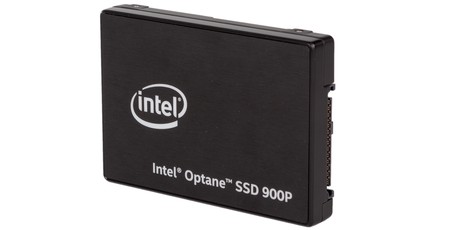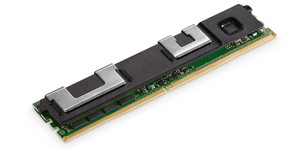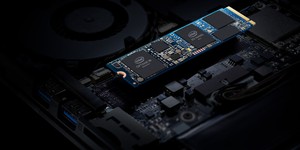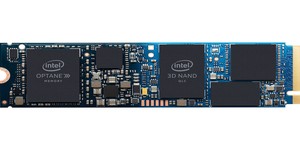
Manufacturer: Intel
UK price (as reviewed): £226.92 (inc. VAT)
US price (as reviewed): $259.99 (exc. tax)
Like the WD Black SN750 SSD, the Intel Optane SSD 900P is a product that’s been sat on the review shelf for some time, but it’s perhaps testament to the revolutionary nature of Intel and Micron’s 3D XPoint memory medium that there is still nothing else like it on the market and that – for a certain subset of users at least – it remains a very relevant product.
Broadly speaking, efficient computing involves keeping the data you need most often as close to the processor as possible to reduce latencies. As datasets exceed volatile system memory – DRAM, typically DDR4 for today’s CPUs – parts need to be shifted onto non-volatile local storage. While never desirable, this was agony prior to widespread SSD adoption, and the PCIe bus and NVMe interface have since allowed NAND flash to really shine.

3D XPoint, however, sits above NAND in the memory hierarchy. Like NAND it is still non-volatile, but it has far higher endurance, much lower latencies, and greater performance consistency over time. The primary downsides are cost per gigabyte, though this is actually an advantage if you compare to DRAM instead of NAND, and power consumption, though the target audience won’t mind much on the latter point.
Co-developed by Intel and Micron, 3D XPoint does – in a rare moment of sense for this industry – what its name suggests, as it is a stackable (3D) cross-point (this is how you pronounce XPoint) memory structure. It allows individual single-bit memory cells to be accessed, read from, and written to independently (bit-level write access), unlike NAND where you have to write in pages (often 4KB for SSDs) and erase in multi-page blocks. The specific material and manufacturing breakthroughs enabling 3D XPoint are mostly unknown, but with them Intel and Micron have dramatically reduced latencies and boosted endurance relative to NAND, which is much more susceptible to degradation as you write to it.
| Intel Optane SSD 900P Specs | 280GB | 480GB | |
|---|---|---|---|
| Form factor | U.2 2.5" 15mm | HHHL PCIe AIC | HHHL PCIe AIC |
| Interface | PCIe 3.0 x4 32Gbps NVMe | ||
| Controller | Intel SLL3D | ||
| NAND dies | 3D XPoint 128Gb | ||
| DRAM | N/A | ||
| Endurance | 5.11 PBW (~2.8TB/day) | 8.76 PBW (~4.8TB/day) | |
| Warranty | Five years | ||
Coming back to the SSD 900P, it comes in two sizes: 280GB and 480GB. Both are available as PCIe add-in cards (AICs), and the smaller size is also sold in the mostly untapped U.2 form factor, and this is the one we have for review.

Once a relatively common sight on new motherboards as manufacturers sought to check a box and ensure compatibility if it took off, U.2 connectivity is now much rarer to see, most likely because there just isn’t enough product or demand to justify the inclusion. Both Intel and Samsung have enterprise U.2 drives, but thus far this 280GB drive is the only consumer-grade one available.
| Intel Optane SSD 900P | 280GB | 480GB |
|---|---|---|
| Max Sequential Read | 2,500MB/s | |
| Max Sequential Write | 2,000MB/s | |
| Max Random Read (4K QD32) | 550K IOPS | |
| Max Random Write (4K QD32) | 500K IOPS | |
| Latency Read | 10 μs | |
| Latency Write | 10 μs | |
| Power - Active | 14W | |
| Power - Idle | 5W | |
Regardless of form factor, this is a PCIe 3.0 x4 NVMe SSD much like M.2 SSDs. Unlike NVMe versus SATA, the advantage of 3D XPoint over NAND isn’t a raw throughput improvement, so none of the peak speeds are record breaking. However, there are key performance advantages when it comes to latency and consistency, so you’ll see much faster random access times and the ability to maintain peak throughput across heavy sustained loads.
The five-year warranty period is in-line with high-end consumer SSDs, but the endurance rating of 511 PB written far outstrips them (usually it’s measured in TB written). The enterprise-grade P4800X drives go even higher than this, but here it is a hard limit, so if the endurance rating is actually reached the drive will lock off in a read-only mode. It’s annoying that this is an artificial limit, but it’s done to stop enterprise customers opting for cheaper consumer products, and, you know, 511 PB is a lot of data, the equivalent of 10 full drive writes every day for five years.

The drive comes with the a good-quality power/data cable that receives a regular SATA power header on your PSU. You also get four mounting screws, although the 15mm z-height of the unit precludes it from being mounted in certain tool-free caddies and possibly even in some cases on trays behind the motherboard, for example. Thankfully, most 3.5” mounts have the necessary 2.5” mounts and are tall enough to accommodate it just fine.

The PCB inside hosts the rather large controller and a bunch of NAND packages, and heavy use of thermal padding connects these components to the outer metal shell that acts as a passive heatsink. After all, the drive consumes 4W when idle and up to 15W when active. There are grooves on one side to maximise surface area too. Note that there is no DRAM onboard as 3D Xpoint does away with the need for it.

Since the SSD 900P was launched, the SSD 905P family has also come out, expanding the consumer Optane SSD capacities: 380GBin M.2, 480GB in U.2, and 960GB/1.5TB in both AIC and PCIe AIC form factors. There are some speed/power improvements with 905P, but the 900P 280GB U.2 drive remains in the stack and has not been replaced.
About time we took a look at the performance, eh?

MSI MPG Velox 100R Chassis Review
October 14 2021 | 15:04








Want to comment? Please log in.